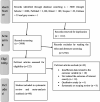Post-abortion family planning use and its determinants among women who received abortion care in sub-Saharan Africa: a systematic review and meta-analysis
- PMID: 40495240
- PMCID: PMC12150515
- DOI: 10.1186/s13643-025-02837-9
Post-abortion family planning use and its determinants among women who received abortion care in sub-Saharan Africa: a systematic review and meta-analysis
Abstract
Background: Post-abortion family planning (PAFP) refers to the use of modern contraceptive methods, preferably immediately following an abortion and within 48 h of the abortion, or before fertility returns. It is highly recommended to delay pregnancy for at least 6 months following an induced or spontaneous abortion to reduce the occurrence of adverse maternal and neonatal outcomes. In sub-Saharan Africa (SSA), there is a high burden of unsafe abortions and an unintended pregnancy rate. Additionally, there are inconsistent study findings that have been done to investigate the prevalence and determinant factors of post-abortion family planning use in the region.
Methods: This systematic review followed standard methods and reported as per the Preferred Reporting Items for Systematic Reviews and Meta-Analyses (PRISMA) guidelines. The protocol for this study was registered in the International Prospective Register of Systematic Reviews (PROSPERO) with reference number CRD42024518297. The eligible publications were searched by PubMed, Research4Life, Scopus, EMBASE, and Google Scholar. The data were extracted using Microsoft Excel 2019 and analyzed using Stata software version 17. The methodological quality of the included studies was assessed using the Joanna Briggs Institute's (JBI) Critical Appraisal Checklist. Publication bias was assessed by using the funnel plot and Egger's test. A random-effects model was used to estimate the pooled prevalence of post-abortion family planning. The I2 test was performed to assess the statistical heterogeneity among the included studies.
Results: This systematic review and meta-analysis included 80 eligible articles from 16 sub-Saharan African countries, with a total of 248,299 study participants. The pooled prevalence of post-abortion family planning use in sub-Saharan Africa was 60.67% (95% CI 55.61-65.73). In addition, the commonly adopted contraception methods after abortion were injectables, 34.98% (95% CI 27.59, 42.37), followed by 20.71% (95% CI 17.20, 24.22) of oral contraception pills, and 20.38% (95% CI 16.82, 23.94) utilized implants. Women aged 15-24 years (AOR = 3.40, 95% CI 2.12, 5.44), being married (AOR = 2.70, 95% CI 1.68, 4.34), attaining secondary school (AOR = 2.75, 95% CI 1.62, 4.66) and college or above (AOR = 2.92, 95% CI 1.85, 4.62), unplanned pregnancy (AOR = 5.03, 95% CI 2.93, 8.61), having prior history of abortion (AOR = 1.88, 95% CI 1.35, 2.62), having good knowledge about family planning (AOR = 2.86, 95% CI 2.37, 3.46), prior family planning use (AOR = 3.82, 95% CI 2.62, 5.58), positive attitude towards family planning methods (AOR = 2.78, 95% CI 1.81, 4.28), partner support (AOR = 2.32, 95% CI 1.64, 3.30), and received post-abortion family planning counseling (AOR = 2.86, 95% CI 2.37, 3.46) were predictors that significantly associated with contraceptive utilization following abortion.
Conclusions: This meta-analysis indicates that the pooled prevalence of post-abortion contraception use in sub-Saharan Africa remains low. Therefore, appropriate planning and implementation of effective strategies are crucial to scaling up post-abortion family planning use, including improving educational attainment, advocating for post-abortion contraceptive methods, and providing effective post-abortion family planning counseling.
Systematic review registration: PROSPERO CRD42024518297.
Keywords: Abortion care; Post-abortion; Post-abortion family planning use; Sub-Saharan Africa; Systematic review and meta-analysis.
© 2025. The Author(s).
Conflict of interest statement
Declarations. Ethical approval and consent to participate: Not applicable. Consent for publication: Not applicable. Competing interests: The authors declare that they have no competing interests.
Figures





References
-
- F. Gary Cunningham KJL, Jodi S. Dashe, Barbara L. Hoffman, Catherine Y. Spong, and Brian M. Casey. Williams Obstetrics, 26th edition, 2022. ISBN: 978-1-26-046274-6.
-
- Organization WH. Unsafe abortion: global and regional estimates of incidence of unsafe abortion and associated mortality in 2008. Geneva: World Health Organization; 2011.
-
- Rogers C, Dantas JA. Access to contraception and sexual and reproductive health information post-abortion: a systematic review of literature from low-and middle-income countries. J Fam Plann Reprod Health Care. 2017;43(4):309–18. - PubMed
-
- Gemzell-Danielsson K, Kallner HK. Post abortion contraception. Women’s Health. 2015;11(6):779–84. - PubMed
Publication types
MeSH terms
LinkOut - more resources
Full Text Sources
Medical
Research Materials

